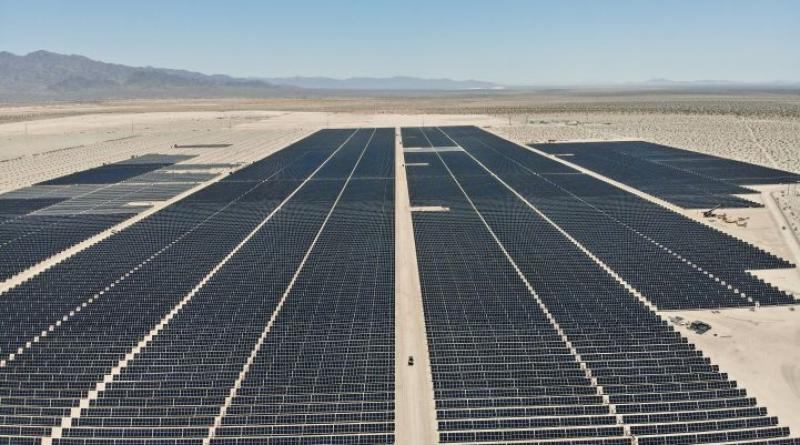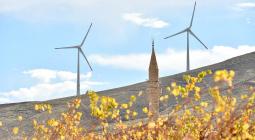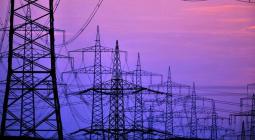Masdar Buys Into 1.6GW EDF Renewables Pipeline in One of the Year’s Biggest Deals.

Masdar and EDF are bringing their global renewables partnership into the U.S. in the midst of a topsy-turvy year.
In one of the U.S. renewable energy market’s biggest deals in a challenging year, Masdar is set to acquire a 50 percent stake in a 1.6-gigawatt portfolio of advanced wind, solar and energy storage projects from EDF Renewables North America.
The deal, expected to close later this year, represents a new front in the global renewables collaboration between EDF and Masdar, which to date has largely focused on the Middle East and North Africa.
Last year, state-owned Masdar, part of the United Arab Emirates’ Mubadala Investment Corp., made its first foray into the U.S. renewables market, buying stakes in two smaller wind farms from the U.K.-based John Laing Group. Mubadala is one of the world's largest sovereign wealth funds.
The latest eight-project deal with EDF is a big step up. Masdar will buy half-stakes in three wind farms in Nebraska and Texas totaling 815 megawatts, as well as five solar projects in California — two with batteries — totaling 689 megawatts of PV and 75 megawatts of storage.
All but one of the projects are due for completion in 2020, with one of the solar plants expected online next year. The financial terms of the deal have not been revealed.
Aside from its sheer size, the deal is important for having come together during the COVID-19 pandemic, Raphael Declercq, executive vice president for portfolio strategy at EDF Renewables North America, said in an interview.
“There was strong interest in this portfolio, which I think really contrasts with the...[2008 Great Recession when] renewables were still on the fringe,” Declercq said. “The capital markets were unsure if they were going to invest in renewables at that time.”
“This time around, I think capital is still there for renewables, and [it is] here to stay,” he said. “We’re in a crisis, yet we’re finding ways to raise money.”
“I think the bigger challenge will be tax equity in the midterm if the economic crisis deepens and there’s no substitute [put forward by] the federal government. But as far as common equity is concerned, it’s very much available for U.S. renewables, and that’s very good news.”
Masdar, whose strategic focus goes beyond profit alone and into areas like economic diversification for the UAE, has invested in a wide-ranging portfolio of renewable energy technologies and projects around the world. Its portfolio runs from solar PV to concentrated solar power, traditional offshore wind to floating turbines. The deal with EDF appears to be its largest investment to date in energy storage.
“The U.S. offers considerable scope for further growth and diversification of our renewable energy portfolio,” Masdar CEO Mohamed Jameel Al Ramahi said in a statement.
The UAE is a major oil-producing nation; with a population of less than 10 million, it was the world's seventh-largest oil producer in 2019, according to the U.S. government.
EDF, which is currently building the Middle East’s largest wind farm in Saudi Arabia in partnership with Masdar, may work with Masdar further in the U.S., though there’s no formal framework in place, Declercq said. EDF Renewables North America often brings investors onto its projects, which it continues to co-own and operate.
“We’ve stayed away from listed vehicles like yieldcos or unlisted vehicles that mimic what the yieldcos are doing,” Declercq said. “We very much like repeat business, though. If you look at what we’ve done with some other financial investors, like BlackRock for example, we’ve done repeat business with them — and that’s certainly a possibility with Masdar.”
EDF's portfolio continues to shift toward solar
Long one of the country's leading renewables developers, EDF Renewables North America is planning to complete 2 gigawatts of capacity in the U.S. this year, more than it ever has, CEO Tristan Grimbert told GTM.
“It’s also likely the most difficult year in terms of bringing all that [capacity] to market,” Grimbert added, referring to coronavirus-related delays and other challenges.
He said the company is benefiting from having had an unusually advanced construction program in 2020, to make sure its projects were finished well before the end-of-year deadline for federal wind-energy tax credits.
“That’s given us the ability to slide a little bit,” Grimbert said.
2020 and 2021 will be peak years for U.S. renewables construction due to the tax credit deadlines, but EDF believes the market will recover quickly as the technology mix evolves.
“In the past, our portfolio was 85 percent wind,” Grimbert said. “If you look into the future, we’re like 70 percent solar.”
As the dust settles on the federal subsidy programs, “we’re pretty confident that the markets will remain steady and we’ll be able to build 1-gigawatt-plus for the foreseeable future.”
13 August 2020
gtm




